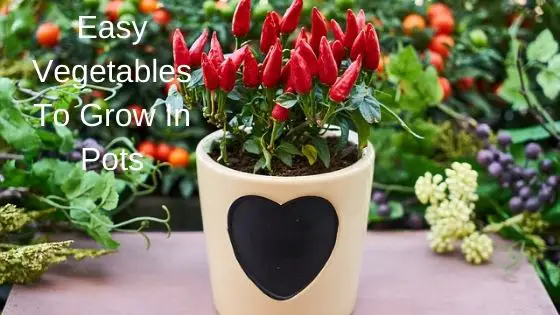Not everyone has a large garden or allotment, but that doesn’t mean you can’t grow your own vegetables. There are many easy vegetables to grow in pots and in this post you’ll find the easiest. Even if you’ve never grown anything in your life, after reading this I guarantee you’ll be able to harvest your own home grown healthy vegetables.
Easy Vegetables To Grow In Pots
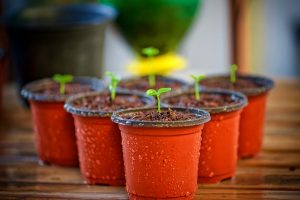
Some of the following are very easy to grow and some take slightly more care, so let’s start with the easiest and work up to the slightly more difficult. A quick word about seed sowing, if this is all new to you, don’t worry about getting bogged down with technicalities. The basic rule of thumb is sow the seeds roughly twice as deep as the seed actually is, so the larger the seed, the deeper it gets buried.
Radishes

Radishes have to be the easiest vegetable to grow, they have everything going for them. Firstly the seeds are fairly large, making them easy to handle, secondly they grow in 5-6 weeks from sowing to harvesting. Just fill a container with compost or soil, spread the radish seeds, cover with a light topping of soil, and water.
That’s it! As simple as that, well nearly, they need to be kept in damp soil, that’s damp, not drowning wet. Plus they need sunlight, but as long as they are outdoors they’ll probably get enough of that.
The other things to remember about radishes are they do better in cooler conditions like early Spring and early Autumn. Plus they don’t do so well in really hot, dry conditions, and they don’t handle frost too well either. But you never really tasted a radish until you’ve had it fresh from the soil.
Cress
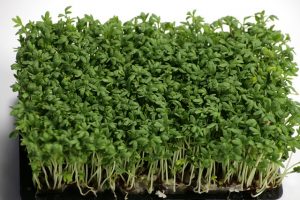
This has to be the easiest vegetable to grow ever! You don’t even need any outdoor space, or come to that a plant pot. Cress will grow on damp kitchen towel, or in shallow soil on a sunny windowsill.
There’s probably not many people who didn’t grow cress at school as a child, and that’s why it’s easy to dismiss cress as not being a “serious” vegetable. Whereas in fact common garden cress contains Vitamin K, Vitamin C, Vitamin A, Manganese, Potassium, and Magnesium. Depending on conditions, cress can be grown from seed to harvestable crop in 5-7 days.
Spinach
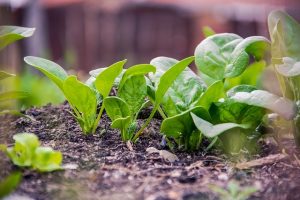
You’ll need a fairly large pot for spinach as it grows to a fair size. Just fill the pot with soil/compost and sow your seeds. Keep the soil moist and soon you’ll have healthy spinach leaves to add to your dinner plates.
Harvest from the outside of the plant allowing the central leaves to grow and develop for later use. For a continuous supply, it’s best to have 2 or more pots of spinach on the go. This allows one to grow whilst you harvest from the other.
Lettuce
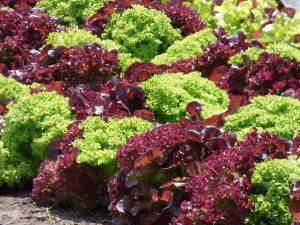
Instead of growing heads of lettuce I prefer to grow the so called “cut and come again” types of lettuce. This is because it allows me to have lettuce on a steady stream as opposed to one large head and then nothing. So choose the more leafy types of lettuce like Lollo Rosso, Oak Leaf, or one of the many other loose leaf type lettuces.
Lettuce is among the easiest vegetables to grow in pots but remember, lettuce prefers cooler temperatures. Plus, they are susceptible to slug and snail damage, so that’s something to be aware of. If you spot slug/snail damage lift up each pot and surrounding pots because slugs particularly like to hide under pots.
Another thing worth noting, is lettuce seeds are quite small. Don’t worry if you over sow, the excess seedlings can be removed once your seeds germinate. Just snip the excess seedlings with scissors or try to gently lift some from the soil and replant them elsewhere.
If you lose the transplants it’s not the end of the world but, you might just get a bonus crop. After a few weeks of picking, the lettuce plants will start to produce flower buds. That’s the time to start again, because once the flower buds form, the leaves will taste bitter.
Carrots

Some of you more advanced gardeners might be thinking carrots? I thought this was easy vegetables to grow in pots. Well if done correctly, they are.
Firstly choose a variety that’s suited to growing in a container, something like Paris Market or Chanternay. Short growing varieties like these will grow well in a bucket or similar. Fill the container with soil/compost and sprinkle carrot seeds on the surface, cover with a light covering of soil.
Water well and cover the container with a piece of glass or polythene, anything that will keep moisture in and allow sunlight to enter also. Once seeds germinate, remove glass or polythene, then, they can be thinned out by cutting them with scissors to allow enough space for each carrot to grow. Try to not water too often, because it’s the root that needs to develop, by keeping the top soil relatively dry, the root will search deeper into the soil.
After around 12 weeks the carrots will be ready to harvest. There’s a trick to make harvesting carrots easier, just push the carrot down deeper into the soil and twist slightly. Then pull the carrot out of the soil, pushing it downwards and twisting first helps to loosen the roots in the soil.
Swiss Chard

This nutritious vegetable is available in many colours and is as easy to grow as spinach. In fact grow it in exactly the same way as spinach and harvest it in the same way too.
Chillies
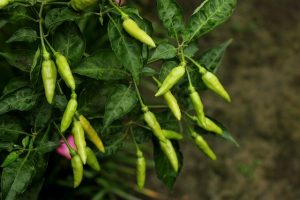
These seasonal plants are well suited to growing in pots, and can be purchased already growing. Thus making them a very easy vegetable to grow in pots. The only problem with store bought chilli plants is there’s not too much choice in varieties.
Seed germination for chillies can be a bit sporadic but adding heat and moisture improves germination a great deal. Try starting the seeds off in a sealed container placed in an airing cupboard or on top of a boiler.
Once plants are established don’t allow the soil to dry out completely but don’t over water either. Feed once a week with tomato feed once flowers form.
Tomatoes
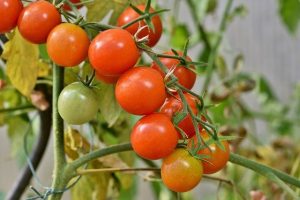
The easiest tomatoes to grow in pots are bush tomatoes, otherwise known as determinate types. These will only produce one crop of tomatoes and once they are all picked, the plants should be replaced. Varieties include Gardeners Delight and Tumbling Tom, there are many more these are just for example.
Treat in the same way as chillies except be consistant with your watering, otherwise problems like blossom end rot and fruit splitting will ruin your crop. Everyone should grow tomatoes as there is no better taste than fresh picked, home grown tomatoes.
Beans
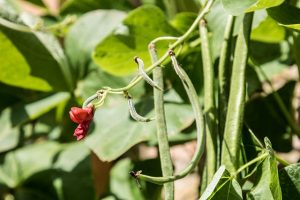
Both types of beans can be grown in pots, pole and bush beans need similar growing requirements and conditions. I find it useful to bury some old newspaper around 6 inches below the surface of the soil, this will ensure the beans never dry out. Sow bean seeds around 4 inches apart and water regularly.
Like chillies and tomatoes, beans will appreciate feeding with a tomato food once a week once flowers form. Depending on type this is all the attention they need. The differences are pole beans need supporting with either canes or a string structure and bush beans need no such support.
Water regularly and only feed when soil is moist, feeding when the plants need water will damage the plants. Harvest when beans are large enough but don’t allow them to get too large as they will be tough to eat.
Beetroot
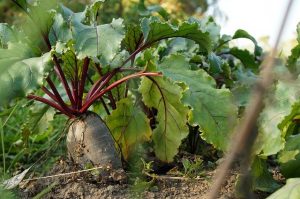
Another highly nutritious vegetable that is easy to grow in pots. A quick word on beetroot seeds, these are what’s known as cluster seeds. Basically each seed is composed of at least 3 seeds.
If they all germinate some thinning out will be required, again this is where the scissors come in handy. Roughly 12 weeks from sowing the beetroots will be ready to harvest. Try grating fresh pulled beetroot onto a salad, the flavour is spectacular.
Peas

Grow peas in exactly the same way as beans, they take around 50-60 days to produce edible pods. Peas can be eaten raw or lightly boiled in water for no longer than 2 minutes. Young pods can also be eaten and are often used in stir frys.
Pea shoots also make a nice addition to a salad, and if you’re growing for pea shoots the harvest time is much quicker.
Potatoes
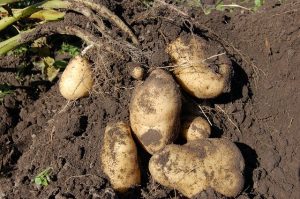
In a large container, place around 4 inches of soil and add 3 potatoes evenly spread out around the pot. Cover with another 4 inches of soil, and water. once the leaves grow 4 inches above the soil, cover with another 4 inches of soil.
Continue this ’til the pot is full and then wait until the plants start to die back naturally. I say naturally because you don’t want to under water them which can also cause them to die back. Harvest time is around 3-4 months depending on variety.
Garlic
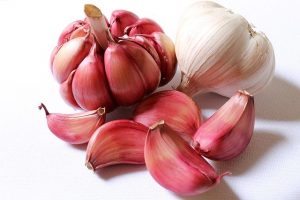
Growing garlic is easy, and it lends itself to container growing very well. Each individual clove becomes a whole bulb of fresh garlic. Just separate each clove and bury in the soil pointy end facing the sky.
Garlic does best if it’s allowed to get a cold period, with at least 7 continuous days/nights of frost. So it’s best to grow garlic outdoors and the best time to plant it is late Autumn. In fact garlic was originally planted on the 31st of October(halloween) and this might explain the link with vampires???
It takes a while to grow, from an October planting you’re looking at early to mid May before it’ll be ready to harvest. Give garlic a go, it takes little to no maintenance just water in extremely dry periods.
Onions
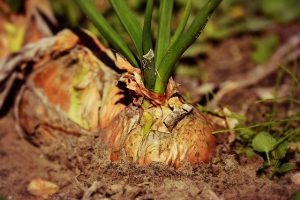
The easiest way to grow onions is from sets, this limits the amount of varieties but ensures a successful harvest. Onion sets are just like bulbs and should be planted in the same manner. If you want to grow different varieties from seed allow more time for development and growth.
Spring onions otherwise known as green onions or salad onions can easily be grown from seed, plus once they are ready to harvest you can get a second crop. To get 2 or even 3 crops from spring onions just cut the onion off the plant leaving the roots and the bottom section of the plant in the soil. The plant will regrow and this can be repeated.
To learn how to grow green onions from cuttings click this link.
Growing Vegetables In Pots For Beginners
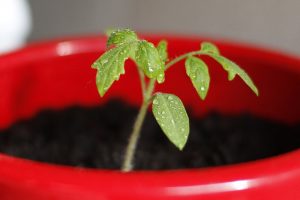
All of the above plants can be grown by novice gardeners, in pots or containers easily. Remember there is no such thing as a green finger, gardening like everything else is about attention to detail. Follow the hints in this post and you will be able to grow your own vegetables.
There are a few more details that will greatly help with your success, but don’t over think it or worry too much. All seeds are embryos, and all have the potential to grow for the perpetuation of their species. So unless you get it drastically wrong there’s a strong chance the vegetables will grow.
Plant Pots
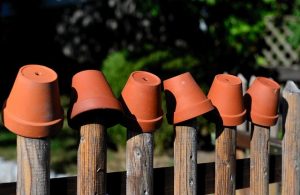
The easiest pots to use for growing vegetables are plastic pots, they are frost resistant and fairly robust. If you use clay pots you need to be aware of the way they can be damaged by frost. Clay pots absorb water, which expands when frozen causing the pot to break.
Metal pots can look attractive but metal holds too much heat which can be detrimental to your plants. They also have a tendency to rust and this can stain your yard. Wooden pots/containers look good but slugs and snails like to hideout on the underside of wood.
Size Matters
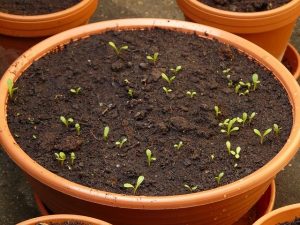
The bigger the pot, the better the growth is the general rule you should stick by. Roots need room to grow and if they are restricted, the plants growth will be stunted. Also a large pot filled with soil will hold extra moisture for longer periods of time.
So next time someone tells you size isn’t everything, remember it is with plant pots. If you have a really large container you might want to consider companion planting vegetables. This is a way of growing more plants in a smaller area with mutual benefits to all plants.
What Vegetables Do Well Together In Containers
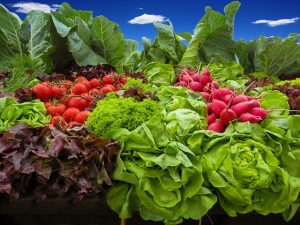
This section could be called companion planting vegetables in pots because that’s what we’re talking about here. Now some people like to say that because there’s a lack of scientific study on companion planting it’s not relevant. I disagree strongly, look at nature, hedgerows, woodlands, forests, all practise companion planting.
Other names include polyculture, intercropping, but it’s all the same thing. Square foot gardening pioneered by Mel Bartholemew back in the 1980s proved that growing plants close together is not detrimental. I have been companion planting with my vegetables for many years and some combinations work better than others.
The general rule for this is keep all alliums(onions, garlic, leeks, chives etc) away from legumes(beans, peas etc) because alliums exude a compound that prevents legumes from fixing nitrogen. You don’t need to know what that means just trust me it’s not good for the beans and peas.
Good combinations include, tomatoes with carrots, tomatoes with onions, beans with tomatoes, beans with spinach/lettuce/swiss chard, chillies with onions. For a more indepth companion planting chart for vegetables follow this link.
Fast Growing Vegetables In Pots
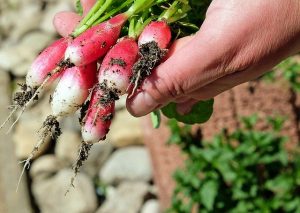
For pot growing, the fastest growing vegetables are without doubt, radishes. Followed by lettuce, spinach, and swiss chard. The absolute fastest is cress coming in at 5-7 days from sowing to harvesting.
With peas and beans taking around 2-3 months, and beetroot and potatoes taking 3-4 months and onions and garlic taking the longest time (apart from spring onions).
Talking Dirty
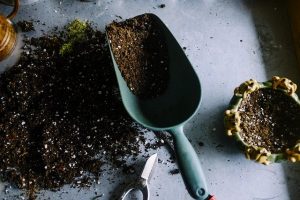
When growing plants in pots the #1 factor that needs to be right, is the dirt. You should go for a proper potting mix or good quality compost. If possible add some perlite or vermiculite, these are both made from porous rocks that will absorb extra moisture.
Containers dry out much faster than soil beds and so the better the quality of the soil the better chance of success you have. The flipside of this is too much water, which will lead to plants suffocating, I know it sounds mental right? But trust me it’s true!
The easiest way to prevent too much water is having adequate drainage holes in your pots and containers.
Weather Warnings

The only other point left to cover is a word about the weather. Most of the crops covered here are best planted from early Spring onwards. The exceptions are garlic which should be started in late October, tomatoes and chillies which should be started around mid April, along with peas and beans.
Follow this advice and you will very soon begin to harvest your own, home grown, fresh, healthy vegetables.

